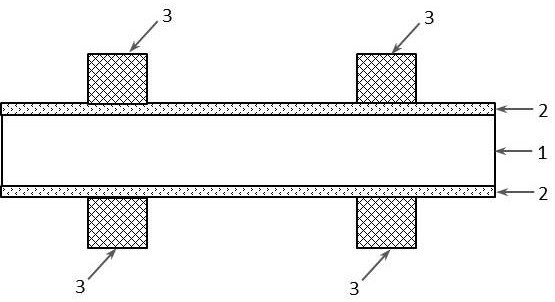Heterojunction solar cell and preparation method and application thereof
A solar cell and heterojunction technology, applied in the field of solar cells, can solve the problems of reducing the effective area of grid cells, limiting the large-scale application of cells, and the high price of low-temperature silver paste, so as to prevent migration to cells, high open-circuit voltage, The effect of increasing the plateability
- Summary
- Abstract
- Description
- Claims
- Application Information
AI Technical Summary
Problems solved by technology
Method used
Image
Examples
Embodiment 1
[0085] A heterojunction solar cell and a preparation method thereof, the preparation method specifically comprises the following steps:
[0086] (1) The monomer (3,4-ethylenedioxythiophene EDOT and styrene sulfonic acid), emulsifier (sodium stilbene phenol polyoxyethylene ether sulfonate and sodium isooctyl sulfate), initiator (persulfuric acid) Sodium) is mixed with water to prepare a monomer mixture, wherein the concentration of EDOT is 0.1 mol / L, the concentration of styrene sulfonic acid is 0.2 mol / L, and the concentration of sodium stilbene phenol polyoxyethylene ether sulfonate is 2 g / L, the concentration of sodium isooctyl sulfate is 0.5 g / L, and the concentration of sodium persulfate is 0.01 g / L;
[0087] The silicon substrate with the transparent conductive layer (TCO film) was surface-treated with 5% dilute sulfuric acid for 2 min for activation, then immersed in the monomer mixture for 5 min, taken out, and heat-treated at 120 °C for 1 min to obtain A polymer condu...
Embodiment 2
[0094] A heterojunction solar cell and a preparation method thereof, the preparation method specifically comprises the following steps:
[0095] (1) Mix the monomer (EDOT and styrene sulfonic acid), emulsifier (sodium stilbene phenol polyoxyethylene ether sulfonate and sodium isooctyl sulfate), initiator (sodium persulfate) with water to prepare Monomer mixed solution, in which the concentration of EDOT is 0.1 mol / L, the concentration of styrene sulfonic acid is 0.2 mol / L, the concentration of sodium stilbene phenol polyoxyethylene ether sulfonate is 2 g / L, and the concentration of isooctyl sulfonic acid is 2 g / L. The concentration of sodium is 0.5 g / L, and the concentration of sodium persulfate is 0.01 g / L;
[0096]The silicon substrate with the transparent conductive layer (TCO film) was surface-treated with 5% dilute sulfuric acid for 2 min for activation, then immersed in the monomer mixture for 10 min, taken out, and heat-treated at 120 °C for 1 min to obtain A polymer c...
Embodiment 3
[0102] A heterojunction solar cell and a preparation method thereof, the preparation method specifically comprises the following steps:
[0103] (1) Mix the monomer (EDOT and styrene sulfonic acid), emulsifier (sodium stilbene phenol polyoxyethylene ether sulfonate and sodium isooctyl sulfate), initiator (sodium persulfate) with water to prepare Monomer mixed solution, in which the concentration of EDOT is 0.1 mol / L, the concentration of styrene sulfonic acid is 0.2 mol / L, the concentration of sodium stilbene phenol polyoxyethylene ether sulfonate is 2 g / L, and the concentration of isooctyl sulfonic acid is 2 g / L. The concentration of sodium is 0.5 g / L, and the concentration of sodium persulfate is 0.01 g / L;
[0104] The silicon substrate with the transparent conductive layer (TCO film) was surface-treated with 5% dilute sulfuric acid for 2 min for activation, then immersed in the monomer mixture for 10 min, taken out, and heat-treated at 120 °C for 1 min to obtain A polymer ...
PUM
| Property | Measurement | Unit |
|---|---|---|
| thickness | aaaaa | aaaaa |
| thickness | aaaaa | aaaaa |
| thickness | aaaaa | aaaaa |
Abstract
Description
Claims
Application Information
 Login to View More
Login to View More - R&D
- Intellectual Property
- Life Sciences
- Materials
- Tech Scout
- Unparalleled Data Quality
- Higher Quality Content
- 60% Fewer Hallucinations
Browse by: Latest US Patents, China's latest patents, Technical Efficacy Thesaurus, Application Domain, Technology Topic, Popular Technical Reports.
© 2025 PatSnap. All rights reserved.Legal|Privacy policy|Modern Slavery Act Transparency Statement|Sitemap|About US| Contact US: help@patsnap.com



